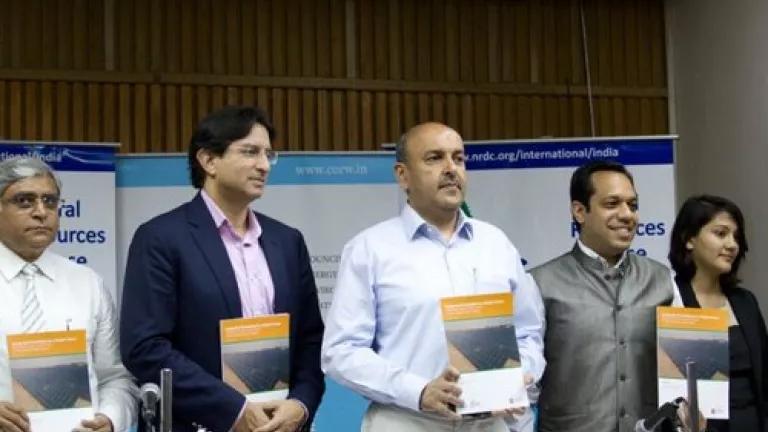
Guest Blog by Dr. Arunabha Ghosh, CEO of Council on Energy, Environment, and Water
In New Delhi, we recently launched our latest report, an evaluation of Phase 1 of India’s National Solar Mission (NSM). Prepared in collaboration with the Natural Resources Defense Council, Laying the Foundation for a Bright Future is the first independent analysis of the entire ecosystem for grid-connected solar power in India. More than 100 participants engaged in a rich and lively discussion. These included, among others: Mr Tarun Kapoor (Joint Secretary in the Ministry of New and Renewable Energy), Mr Rajinder Kaura (Secretary General, Solar Energy Society of India), other industry bodies (CII, SEMI), project developers (such as Azure Power, Punj Lloyd and Welspun), manufacturers (e.g. Tata BP Solar), financial institutions and information channels (State Bank of India, Bloomberg New Energy Finance) and credit rating agencies (CRISIL), research institutions (CSE, Bridge to India, etc.), multilateral institutions and donor agencies (including the Shakti Sustainable Energy Foundation, which generously provided part support for our report). For more information on the report, related factsheets, high-res graphics, additional information and media coverage, see our dedicated page: ceew.in/solar.
Although there is a lot of positive news, especially on the increase in installed grid-connected solar PV capacity, the bankability of projects and the financial needs of the Mission remain concerns and dominated the discussions.
- Financial institutions do not want project developers to aggressively bid low prices and then expect to receive debt financing. Even some developers agreed that at rates like Rs.7.49/kWh, project developers cannot expect to get non-recourse (or off balance sheet) financing.
- Bankers continue to worry about technological obsolescence (but others pointed out that in the United States, for instance, this was not the case).
- There are also worries about the guarantee of payments.While the NSM offers power purchase contracts via the NTPC Vidyut Vyapar Nigam (NVVN), similar guarantees are not available for state-specific solar missions.
- Others argued that strict timelines for commissioning projects can be met only if project selection is linked to project financing, ability to secure land, and a roadmap to develop the infrastructure to evacuate power.
- The biggest hurdle, perhaps, was that the deal sizes were still too small for large financial institutions to bother with the expenses of due diligence. Moreover, if proposals had to be vetted by independent, international experts, then transaction costs would rise further. Meanwhile, while domestic interest rates remain high, some project developers have been able to access overseas finance at rates around 3%-4% lower.
Need for a Financing Ecosystem
These are not new complaints. Our report highlights several types of risk perceptions as well as other concerns, such as lack of credible solar radiation data and need for updates on project deployment and performance. It is clear, though, that different stakeholders are not coming together to resolve the problem. Roundtables between project developers and financial institutions have been promised but have failed to materialise. The National Clean Energy Fund, announced two years ago and which gets a deposit of Rs.50 ($1) per tonne of coal produced, has not been deployed to ease bridge some of the financing gaps evident in solar. Others ask for robust enforcement of the Renewable Portfolio Obligations for states, so that it can stimulate the Renewable Energy Certificate market. But government officials argue that the main source of project guarantees would still have to be long-term power purchase agreements.

In other words, for the India solar industry to grow in its maturing years, a financial ecosystem has to develop. A wide range of funding channels and institutions – public sector banks, multilateral agencies, commercial banks, private financiers and venture capitalists – would have to operate at different levels: strategic, project, and for ancillary support (see the graphic above). Some institutions are better suited for project financing, while others are needed to increase information, to offer payment guarantees, long-term debt, while still others could support R&D, or boost skills development. Do send in your ideas for how we could help to facilitate such a strategic approach to solar finance.
A version of this post originally appeared in Connecting Dots, blog of the Council on Energy, Environment and Water.
Arunabha Ghosh is the Chief Executive Officer of Council on Energy, Environment and Water, an independent think tank based in India.
You can read all his blog posts here.
Photo: courtesy of CEEW
-----
Additional NRDC posts on India’s National Solar Mission:
Frances Beinecke: India's Solar Sector Has Grown Rapidly, Driving down Costs and Slashing Pollution
Anjali Jaiswal: Energizing the Solar Market in India: How Government Policies Are Causing Rapid Growth in Clean Energy
Vignesh Gowrishankar: Making panels where the sun shines: How India's solar manufacturing policy can more effectively support the National Solar Mission